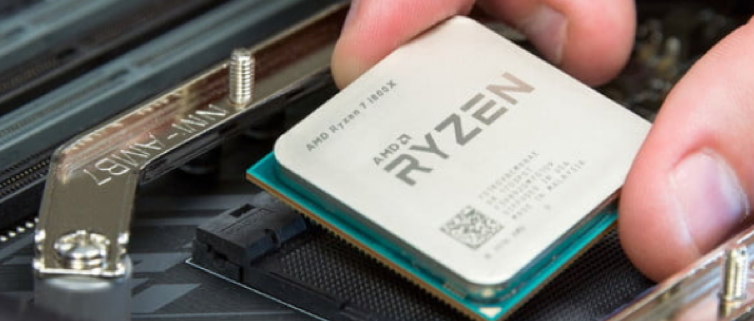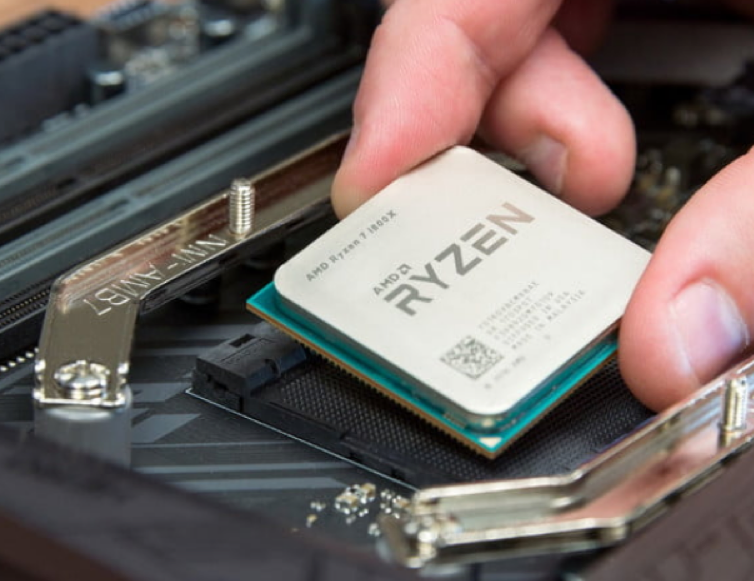“If you decide that you’re going to do only the things you know are going to work, you’re going to leave a lot of opportunity on the table.” Said Founder and CEO of Amazon Jeff Bezos
Mad Hedge Technology Letter
December 4, 2018
Fiat Lux
Featured Trade:
(THE CHIP STOCKS HAVE BOTTOMED)
(NVDA), (AMD), (INTC)
Now that the trade war has officially been put on ice, two short-term trades to scoop up out there for the taking would be chip leaders Advanced Micro Devices (AMD) and Nvidia (NVDA).
Even though I am still bearish on the chip sector as a whole, the mini rapprochement signals a much-needed reprieve to China-sensitive stocks that have been beaten down for most of the year.
The timing is favorable now to jump into some of the avant-garde chip stocks and succinctly two companies that have captured the imagination of the global gaming revolution by constructing the critical GPUs needed to display the mouth-watering graphics that appear life-like.
They are two dominators that have cornered the GPU market and don’t apologize for it.
Even if next year fails to pinpoint a comprehensive détente, China-based supply chains will have more time to make epochal decisions to whether risk the full brunt of a future multilateral spat or mosey on over to greener pastures to insulate themselves from tariff and political fallout.
Most of American tech supply chains are in China now, but that doesn’t mean that can’t change.
Either way, ratcheting down the tone of the jawboning will help chip stocks and the GPU mainstay firms should finish out the year resolutely.
After building an abnormally high amount of inventory due to last year's bitcoin euphoria, Nvidia got ahead of itself drowning in excess GPU units with evaporating crypto mining demand from the bitcoin crash.
It was never imagined that the crypto phenomenon could incite a build-up of inventory channels to the levels that started to erode pricing, but when you consider that two companies and not one were pumping out the GPU units, they simply overdid it.
Conveniently enough, management on both sides blamed each other.
In any case, I believe the spike in inventory says more to the crash and burn of bitcoin pricing than having something to do with these two solidly run companies.
Bitcoin revenue stream only accounted for 10% of revenue at last year’s peak of crypto ecstasy.
The Mad Hedge Technology Letter has steered wide and clear of the crypto phenomenon because even though the blockchain technology is indeed intriguing, there are probably a few more crash and burn scenarios to unfold before it becomes legitimately accepted in mainstream finance.
In any effect, GPU pricing has started to turn the corner up 15% from the September lows, and for the first time since earlier in the year, inventory levels are starting to flush itself out.
The “crypto hangover” headlines roughed up shares of the duopolists but now the light is at the end of the tunnel, and combined with the ceasefire in Washington, has created a positive platform for these two favorites to trade into yearend.
The record-breaking sales volume from Black Friday and Cyber Monday is a minor boost giving credence to the inventory channels clear-up.
Jubilant shoppers were gobbling up GPUs to dish out to gamer friends and family.
At the annual Siggraph conference in Vancouver, Canada, CEO of Nvidia Jensen Huang said, “Turing is Nvidia’s most important innovation in computer graphics in more than a decade.”
The development of real-time ray tracing is the “holy grail” of the GPU industry.
The Turing products render graphics six times faster than their predecessor Pascal-based chip.
Nvidia has rolled out three new graphics cards based on this technology.
In fact, the Turing T4 Cloud GPU has been a massive success in the data center space.
Not only is gaming benefitting from these high-end chips, they can be slotted around offering a diverse set of functionalities.
Ian Buck, Vice President and General Manager of Accelerated Computing at Nvidia said, “We have never before seen such rapid adoption of a data center processor.”
Nvidia’s T4 offers the modern cloud of today the performance and efficiency needed for compute-intensive workloads at scale.
The two companies continue to manufacture top-level GPUs that the competition cannot touch.
The headwinds facing these two titans are of a temporary basis and will eventually dry up.
Both missed on earnings and the stocks sold off badly.
The one-off short-term headwinds will quickly shore up.
The lucky opportunity for investors to get into a best of breed at a cheaper price does not come around too often.
If the near-term fluctuations provide too intense, both companies are great long-term buy and hold stocks.
The bad news has been mostly baked into the pie at this point.
The reset in expectations should factor in the evolving inventory situation and the crypto headwinds.
I fully expect both companies to convincingly beat earnings on the top and bottom line next quarter.
Core gaming demand is robust and by next earnings, the companies will be back to their normal selves – systematically crushing earnings expectations.
This one-off in performance was a curveball, and AMD is a company that I am bullish on with AMD snatching away market share from Intel (INTC).
German’s large tech e-tailer Mindfactory published a survey showing AMD doubling the number of CPUs sold leaving Intel in the dust in November.
Intel’s CPU sales are nosediving quickly because of AMD’s innovative designs and reliable production performance.
Intel has essentially gifted a huge swath of the CPU market to AMD, and AMD has embraced the change and is running with it.
I expect AMD to turn the screws next year on Intel and hoover up more of the CPU market.
Add in that 50% of AMD’s revenue comes from newly launched products and then you can start to cook up why these companies are ahead of the game.
They concoct best in show products leverage with groundbreaking technology and scale up these state-of-the-art offerings to the strongest segments of the chip industry and presto!
You have a magical recipe of success.
At the Mad Hedge Lake Tahoe Conference at the end of October, AMD plummeted to around $17 and I convincingly proclaimed this stock a buy without hesitation.
The stock is up over 25% since then to almost $24, and I believe this stock is in it for the long haul.
“We put ourselves back in the high-end conversation.” – Said CEO of AMD Dr. Lisa Su in 2017
Mad Hedge Technology Letter
December 3, 2018
Fiat Lux
Featured Trade:
(I BET YOU’VE NEVER HEARD OF HUBSPOT)
(HUBS), (CRM)
If you are on the prowl for a cloud-based software company with super-charged growth that is still in the early stages, then I have the one for you.
HubSpot (HUBS) sells online marketing software.
They are the one-stop for CRM (client relationship management), email and sales automation, pretty landing pages, social media marketing, keyword research, website analytics, and lead generation tools all on one platform.
In general, HubSpot targets the SMEs (small and medium enterprises) and offers an intuitively designed product adding value to over 50,000 firms.
They even have a freemium package allowing newbies to sample the power the software tools possess.
This service starts its pricing at $50 per month for the basic package and it may not seem like much.
But then there are the add-ons that guarantee lead to a wave of additional upselling - a boon to quarterly revenue.
The initial price base is usually followed with price increases into the thousands because business needs more contacts to slot into its data silos and features to harness elaborate marketing campaigns.
This is all the cost of doing business and signals that HubSpot has the ability to carve out even more revenue than the starter packages they offer.
If companies are moaning about the boost in costs, I would lash back and say the added costs are warranted because of the enticing surge in productivity that scaling and better tools offer marketers leading to higher performance.
Plus, HubSpot isn’t the only cloud-based software company offering add-on tools to massage the customer’s demands.
These demands are multiplying by the day as marketing software becomes more complicated and sellers require hybrid-solutions to seal the deal with the end-buyer.
Sequentially, HubSpot’s revenue is expanding ferociously up 35% from last quarter.
On a 3-year basis, HubSpot has demonstrated it can uphold a furious pace of growth averaging a 42% growth rate during this time.
The company is still smallish with a market capitalization of $5 billion, but that won’t last for long as revenue expansion will reward shareholders with a higher share price.
Some of the positives from this marketing software is that its quality is highly competitive with other industry players such as Infusionsoft.
There will be certain companies that fit different software as marketing software is incredibly diverse.
The way that developers approach certain tools will naturally result in a different product altogether.
Specifically, I favor the centralization of HubSpot’s tools.
The holistic nature of HubSpot’s software makes the sum of the parts more valuable.
Online marketing is not just a one-day fly-by-night operation. Industry professionals would admit it’s an arduous grind. They must commit to one platform because HubSpot has made it hard to hop around.
Specifically, I like that HubSpot locks up companies with 1-year contracts instead of a rolling month-to-month contract that encourages companies to jump ship whenever there is an incremental upgrade elsewhere.
This has the effect of smoothing over revenue with the recurring billing helping the CFO plan the future allocation of the company and, most importantly, retaining its core customer base.
HubSpot also charges for technical support topping up its revenue by deciding to avoid giving this service for free. Professional guidance shouldn’t be free and, in digital marketing, you pay for what you get, period.
Catering towards its lower-end customers, HubSpot offers a comprehensive training and extensive support material making the platform easy to maneuver around from the get-go.
HubSpot is also integrated into Salesforce showing that it doesn’t have to be the star of the show all the time but can play the role of supporting actor just as well.
Revenue is revenue.
But I would personally go even further and claim that HubSpot’s functionality not only blows Infusionsoft’s, an online marketing competitor, out of the water, but it pushes omnipotent Salesforce (CRM) to its limits.
All of this means that HubSpot is predicted to surpass revenue of $500 million in 2018 after posting revenue of $375 million last year.
HubSpot doubled sales revenue in just two years.
Even though they are expanding from a small base and is blown out of the water by Salesforce on this metric, they are doing exactly what companies this size should be doing in the tech industry.
Stalling growth like over at Venice Beach at Snapchat’s (SNAP) headquarter is a bona fide red flag.
Accelerating revenue is the most pivotal deal-clincher for investors and separates the men between the boys.
Technology is one of the few industries in the economy that have a panoply of companies able to accomplish this feat.
Like it or not, online marketing is one section of tech that is not going away.
Have you realized the heavy stream of emails alerting you to different services and products?
There is a high chance those emails originated from HubSpot and this trend is not going away.
Marketing email volume will only climb until the cost of emails rises substantially which I highly doubt.
Technology is getting cheaper and so is the cost of running a business because of this technology.
Being able to offer poignant tools to its customer base has led to a heavy dose of R&D spending increasing 63% YOY. Even with these higher expenses, HubSpot was able to deliver a stellar EPS beat last quarter posting 17 cents when the consensus was a minuscule 5 cents, beating the forecast by more than three times.
The future looks rosy for this company because we are just in the early innings of the digital revolution for smaller companies.
They will have to migrate or die out.
Even the IT staff at the Mad Hedge Fund Trader has integrated HubSpot into our bevy of software tools and there are no complaints.
The bottom line is that HubSpot grew its customer base 40% YOY to over 52,500.
That is hard to beat.
On the downside, lower average revenue per customer is a concern. The 4% drop is not in tune to what growth companies should demonstrate but I believe the reacceleration of investment into its marketing tools will bear fruit and elevate this dragging number.
That being said, the $9,959 per customer is not a shabby figure at all, and a certain reversion to the mean was due to take place at some point. I would be worried if this drop happened at a much lower average number.
When you delve deeper into the numbers, it appears as if the culprit was HubSpot offering too many teaser starter packages to lure in new business.
Therefore, a slight pricing hiccup for this online marketing company is a one-off and can easily be rectified by upselling its pricing packages from a more advantageous starting point.
HubSpot doesn’t need to dig deeper into the lower end of the bush league and pull out all the nasties.
Moving forward, the roadmap looks fruitful as HubSpot plans to migrate from the smaller companies to higher end and more lucrative business boding well for margin expansion and future average revenue per customer.
This will feedback growing capital into its R&D to develop even more shiny tools for these more advanced marketers.
Shares of HubSpot are a little frothy at this point, and if shares pull back to $120, it would serve as a premium entry point.
Online marketing works well and new business will be up for grabs as a whole slew of companies pivot towards online marketing giving HubSpot a chance to slice off another massive chunk of business powering up annual revenue.
If you have a small business and are considering traversing into the world of online marketing, then visit HubSpot’s website at https://www.hubspot.com
“There’ll always be serendipity involved in discovery.” – Said Founder and CEO of Amazon Jeff Bezos
Mad Hedge Technology Letter
November 29, 2018
Fiat Lux
Featured Trade:
(SALESFORCE KNOCKS IT OUT OF THE PARK)
(CRM), (AAPL), (PYPL), (ADBE), (TWLO), (MSFT), (AMZN)
It’s been a grueling winter for tech stocks and countless number of positive earnings reports have fell on deaf ears.
Will the bloodletting stop?
Not if Salesforce (CRM) has something to say about it!
And if you thought that tech’s secular tailwinds had vanished, this latest earnings report confirmed that software stocks are alive and are as potent as ever.
That is why I have identified software stocks as the best tech play in the current late-stage economic cycle.
At the Mad Hedge Lake Tahoe Conference, I clearly telegraphed that companies do not pour capital into capex for large and risky projects at this late stage, they search for the additional incremental dollar by arming their staff with optimal and efficient software programs to squeeze more juice out of the lemon.
Salesforce is a great example of this.
Moving forward, Salesforce is on the A-team of the software squad, and ideally positioned to harpoon any whales that come near their boat.
Companies are looking to double down on software initiatives at this point which is another reason why annual IT budgets have shot through the roof.
I have met countless CEOs who guide thousands of staff throughout branches around the world and they told me that one of the big in-house additions has been integrating Salesforce as the main customer relationship management system deleting legacy systems of yore that have pooped out.
The switch bears fruits immediately with operations supercharged like a 5-star high school football prospect on his first month of ‘roids.
Simply put, everything just works a lot better with access to this software.
What CEO wouldn’t want that?
Even more salient is that Salesforce has promoted itself as the emblematic tech growth stock promising to smash $16 billion of annual revenue by next year.
I love that Salesforce commits to ambitious sales targets and always delivers the goods.
A talking head on a prominent financial TV show went on record saying that Apple is the key to the tech narrative perpetuating, I would completely disagree with this statement.
Everyone and his mother have absorbed that Apple iPhones sales have plateaued, I am honestly sick of hearing the same story in the news over and over again.
That is why Apple has been trying to morph into a software and service stock. They are doing a great job at it by the way.
The real conclusive acid test to the tech story are these high growth software stocks because they should be the ones outperforming at this stage in the economic cycle.
If companies tilted towards software like Salesforce, Twilio (TWLO), PayPal (PYPL), Microsoft (MSFT), and Adobe (ADBE), just to name a few of the crown jewels of software stocks, start laying eggs then I would admit the tech story is dead.
But it’s not.
Salesforce is poised to continue its ascent and that basically means quarterly sales growth in the mid-20s for the foreseeable future.
There is an addressable market of $200 billion and the pipeline is rich as ever could be.
Salesforce has really turned the corner with free cash flow and profitability. It was only a few years ago they were turning in heavy losses, but this new Salesforce will be even more profitable as the network effect makes the sum of the parts and each add-on cloud-based software tool even more valuable.
Companies just love the breadth of functionality that Salesforce offers and their pension for product enhancement is really owed to CEO Marc Benioff who never shies away from calling his peers out and never cuts corners.
In fact, Marc Benioff is one of the good guys in an increasingly rotting Silicon Valley, part of this has to do with him growing up as a local lad in Burlingame, just a stone throw from his newly built palatial Salesforce Tower gracing downtown San Francisco’s picturesque skyline.
Benioff has more skin in the game as a local and publicly supported Proposition C, effectively a bill that would charge a homeless tax on big earning corporations in San Francisco.
Benioff has also promised to fund any subsequent legal attack that attempts to unravel this homeless tax putting his money where his mouth is.
Benioff noted that he has seen no softness in the macro spending environment.
And even with all the crazy headlines spinning around in the media, there has been no material impact from any supposed peak or downshift in the business environment.
Not only is Salesforce dredging up SME deals at a fast rate, they are quickly targeting the big kahunas.
The number of deals generating more than $1 million was up 46% YOY in the third quarter.
The volume of $20 million-plus relationships is also growing significantly.
In the past quarter, Salesforce renewed and expanded a 9-figure relationship with one of the largest banks in the world.
Salesforce is able to upsell their cloud tools to customers and these firms eat up the Einstein built-in functionality that uses artificial intelligence to improve the existing software.
North America comprised 71% of total revenue which is why this software company will reap the rewards for any extension of this economic cycle because they are largely domestic and best in show.
Salesforce beat and raised its outlook calming the frayed nerves of investors looking to dump software stocks.
Just look at the billings growth that was anticipated at 19%, Salesforce smashed it by 8% coming in at 27%.
Not only are they scooping up new customers, but renewals have been just as robust.
The truth is that Salesforce can’t roll out enough cloud-based software products to meet the insatiable demand.
All of this backs up my thesis that software stocks will be the outsized winners of 2019.
The FANGs are not dead, I rather hold an Amazon (AMZN) or Apple (AAPL) long term if I had the choice.
But at this stage, investors should be piling into all the crème de la crème software stocks.
Avoid them at your peril.
“Technology's always taken jobs out of the system, and what you hope is that technology's going to put those jobs back in, too. That's what we call productivity.” – Said CEO of Salesforce Marc Benioff
Legal Disclaimer
There is a very high degree of risk involved in trading. Past results are not indicative of future returns. MadHedgeFundTrader.com and all individuals affiliated with this site assume no responsibilities for your trading and investment results. The indicators, strategies, columns, articles and all other features are for educational purposes only and should not be construed as investment advice. Information for futures trading observations are obtained from sources believed to be reliable, but we do not warrant its completeness or accuracy, or warrant any results from the use of the information. Your use of the trading observations is entirely at your own risk and it is your sole responsibility to evaluate the accuracy, completeness and usefulness of the information. You must assess the risk of any trade with your broker and make your own independent decisions regarding any securities mentioned herein. Affiliates of MadHedgeFundTrader.com may have a position or effect transactions in the securities described herein (or options thereon) and/or otherwise employ trading strategies that may be consistent or inconsistent with the provided strategies.

















